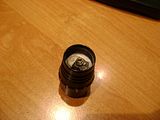Re: 445nm Casio Laser Diode Compilation Thread
One thing I do not understand , folks.
They used 24x blue laser diodes of cutting edge technology yet to bloom in laser market in video projector, totaling output of around 14W (!) - to get BLUE color, but a red LED emitter to get red?!
Where is the common sense in that?!
Is if they were deliberately targeting laser community.
As Mario said in that matter "Not that I'm complaining", same applies here,
I'm just a very nosy person so...
How does that fit in?
There is also another possible explanation, about this ..... as you probably know, we already have 30W and 50W red LEDs, but i never heard about a 30W red LASER diode ..... not at a price that an human can afford, at least

..... and there you don't need coherent light, after all ..... so, muuuuuuch more cheap using a 30 or 50 W LED chip, for the red ..... (and remember that you need at least the double of the flux from red, for equipare green and blue in white mixing, due to the relatively low perception of red ..... all the video panels for megascreens that i know, as example, uses RRGB, nor RGB, with one chip blue, one chip green and TWO chips red for each pixel .....)
And about why use lasers for the blue, instead LEDs, well, blue and green LEDs are still less efficent than red, at first, and second, using the beam also for green production, with a phosphor wheel, is much more simple, optically, to have laser beams already collimated, than have to collimate a multichip blue LED on a small spot, too .....
EDIT: @rev0: Why don't use pure current sources, then, instead just voltage regulators used as current sources ?
The LT3080-1 can give you 1A, the "-1" are directly parallelable, without need extra decoupling resistors (anyway, also the "standard" ones can be paralleled with an extra 0.1 ohm resistor for each chip

), and the current regulation can be done using high value trimmers ..... wondering why none uses them ..... i made a pair of current drivers with the samples that i got from Linear (only 2, unfortunately they don't give more samples) ..... decent stability, and with a sense resistor of 0,2 ohm and a 20 Kohm trimmer, i can regulate it from approximatively 0 to 1 A with a total dropout around
0,6V Sorry, typo, it was 1,6V ..... isn't this good enough, for a linear current source ?





